In researching a recent donation to the Ohio Historical Society it became apparent that the short lived Ohio based camera company, Ciro Cameras, had become largely forgotten. Without texts from OHS collections and blogging camera enthusiasts, Ciro-flex and Ciro-35 cameras would be resigned to dusty attics and thrift store shelves. This donation gave us a chance to rediscover an Ohio treasure. Ciro-flex was once one of the most popular Twin Lens Reflex Cameras in the country.
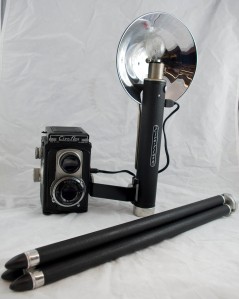
Ciro-flex camera, model unknown, with attached Ciro-Flash and coordinating Ciro-Pod. From the Ralph Ramey collection at the Ohio Historical Society.
Though photography has been around in some form or another since 1814, they were extremely large, expensive, and largely ineffective. The invention of paper based photographic film by Kodak founder Eastman in 1884 put photography well on its way to portability. With easy to use film new camera models began churning out, getting smaller and more functional as they progressed. Rolleiflex out of Germany developed the first compact Twin Lens Reflex Camera (TLR) for public use in 1921. These were very popular with consumers in both Europe and the United States. Trade embargos, military contracts, material shortages, and financial restrictions during World War II changed the dynamic of TLR cameras in the US. Rolleiflex cameras were no longer easy to obtain and prices began to rise. Enter Ciro Cameras Inc. Ciro Cameras was founded in 1941 by a former Ford engineer and French immigrant, Rodolphe Stahl, in Detroit, Michigan. The new company was approached by Sears and Roebuck to create a TRL camera for sale in their stores. Stahl produced the Marvel-flex for Sears and simultaneously released the nearly identical Ciro-flex through his own company.
Dubbed the working mans Rolleiflex, the Ciro-flex benefited from US production during WWII, affordability, and aesthetic simplicity. If not for the stuttering flow of exportation from Germany during and after the war Ciro-flex may never have existed. Ciro Cameras relocated to Delaware, Ohio, in 1947. This move was prompted by Stahl because he felt that the rural atmosphere and the near by college made Delaware, OH an ideal place to live. The camera company moved into a former chicken processing warehouse at 425 S. Sandusky and continued its growth. At the companys peak, Ciro Cameras employed 136 Ohioans and produced 100 cameras per day.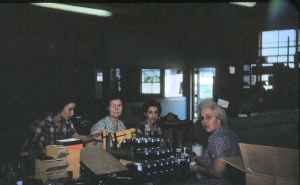
Inside the Delaware, Ohio, Ciro Cameras Factory, photograph courtesy of Richard Browning
While located in Detroit, MI, Ciro Cameras produced three Ciro-flex models: A, B, and C. There are major technical differences between all Ciro-flex models; however not many are apparent to the naked eye. Ciro-flex As are the easiest to distinguish because the logo on the camera is arched instead of straight; otherwise all Ciro-flex models are distinguishable into two categories by lenses. Ciro-flex B, and later D, were fitted with Alphax Synchromatic lenses while Ciro-flex C, and later E, were fitted with Rapax Synchromatic lenses. The Ciro-flex A was dropped during the move from Detroit, MI, to Delaware, OH. Once headquartered in Ohio, Ciro Cameras continued to produce the B and C models while they launched the Ciro-flex D and E as upgrades to those models. In 1950 launched their most advance TLR camera, the Ciro-flex F. Various accessories were added to the Ciro-flex family throughout production, including the Ciro-pod, the Ciro-flash, and various cases. Thanks to a recent donation, the OHS has representations of nearly every model and accessory produced by Ciro Cameras during its Ohio tenure.
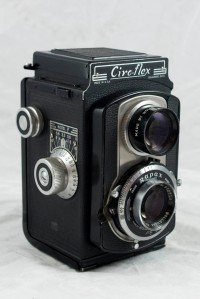
Ciro-Flex, model F. From the Ralph Ramey collection at the Ohio Historical Society.
Ciro-flex cameras were so popular amongst American consumers that it prompted Bruce Downs to write his book Photography with the Ciro-Flex in 1950. This publication boasts that it is a basic book on Twin-Lens Reflex camera technique and delivers concise information in easy to understand language. The publication of this book further endeared the Ciro-flex and other TLRs to the public.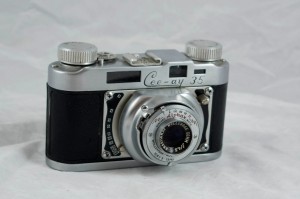
Cee-Ay camera. The plan for this camera was purchased by Ciro Cameras Inc. and rereleased as the Ciro-35. From the Ralph Ramey collection at the Ohio Historical Society.
In 1949, Ciro Cameras purchased designs for the Cee-ay 35 camera. This 35 mm camera was produced by the Candid Camera Corporation of America. Though highly influential, the Cee-ay 35 was only in production for a matter of months before Ciro-flex purchased the design and remarketed it as the Ciro-35.
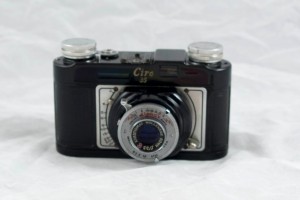
Ciro-35 camera. From the Ralph Ramey collection at the Ohio Historical Society.
Ciro Cameras and all of its models were sold on October 1, 1951 to Graflex Inc. The Ciro-35 and Ciro-flex models were continued for several years under the same name but identified as Graflex products. Eventually, Graflex rebranded the models to the Graflex 22, Ciro-flex, and the Graphic 35, Ciro-35. Even though Ciro Cameras are almost forgotten to history the influence of this small company can be seen throughout the camera industry. The Ohio Historical Society is pleased to acquire such an expansive collection of Ohio made cameras to help us tell the story of Ohio industry, creativity, and immigration.